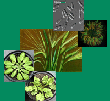| Netondo, Godfrey W; Onyango, John C; Beck, E: Sorghum and Salinity: II. Gas exchange and chlorophyll fluorescence of Sorghum under salter stress, Crop Science, 44, 806-811 (2004), doi:10.2135/cropsci2004.8060 | |
| Abstract: Photosynthetic activity decreases when plants are grown under saline conditions leading to reduced growth and productivity. Leaf growth, gas exchange, and chlorophyll fluorescence of two sorghum [Sorghum bicolor (L.) Moench] varieties, Serena and Seredo, were measured in response to increasing NaCl concentration. Sorghum plants were grown in sand culture under controlled greenhouse conditions. The NaCl concentrations in complete nutrient solution were 0 (control), 50, 100, 150, 200, and 250 mM Salinity significantly (P ≤ 0.01) reduced leaf area by about 86% for both varieties of sorghum. Chlorophyll a and b, net CO2 assimilation, stomatal conductance, and transpiration rate decreased significantly (P ≤ 0.01) with the increase in salinity, and these decreases were similar for the two sorghum varieties. Salt induced decreases for these physiological traits ranged from 75 to 94%. Photochemical efficiency of PSII (Fv/Fm) and photochemical quenching coefficient (qP) decreased by about 9 and 10%, respectively, for both varieties, and electron transport rate (ETR) decreased by 20 and 25% for Serena and Seredo. In contrast, non‐photochemical quenching (NPQ) significantly (P ≤ 0.01) increased by 44 and 50% for Serena and Seredo. The results indicate that salinity affected photosynthesis per unit leaf area indirectly through stomatal closure, and to a smaller extent through direct interference with the photosynthetic apparatus. In addition, salinity decreases whole plant photosynthesis by restricting leaf area expansion. This effect starts from low levels of salinity, in contrast to that of net photosynthesis per unit leaf area, which occurs at higher levels of NaCl concentration. |

